Well, it’s done. After weeks of trawling Craigslist, an hour-long phone call with an intelligent stranger about a different machine that wasn’t going suit my needs, and a two-week delay while the seller and I waited out their unintentional COVID exposure, I am the proud new owner of a vintage Consew 206RB-3 industrial sewing machine.
So far, it is exactly what I wanted — at least a few decades old, in decent shape, built by a reputable maker, and it has a clutch motor that I can upgrade to a servo motor if I wish. I even like the color of the head, the table, and the little drawer hiding on the left side. Connie Consew is perfect!
Decidedly Not Portable
The internet was right — these things are heavy. According to the manual, the machine head alone weighs 25.5 kg (56 lbs). The motor probably weighs another 50-60 lbs. There’s a small wooden peg sticking up from the table that has the job of holding the head whenever it is tilted back for maintenance or bobbin changes. I’ll admit I didn’t trust the little peg at first, but it does a fine job of supporting all that weight on a single point of contact about an inch in diameter.
Even so, the nice lady I bought the machine from offered to deliver it to my house like it was nothing. One of the first things my husband and I did when we went to look at it was try to lift the table. It wasn’t happening for us. But through the magic of a shoulder dolly and the physics of gravity, the seller and her husband floated this thing out to their trailer and drove it across town back to my house.
A Quart Low
So let’s take a tour, shall we? You’ve probably seen a sewing machine before, but there are a few obvious differences with an industrial machine. The biggest one is lubrication. Whereas the instruction manual of the average domestic will tell you to put a single drop of lily white sewing machine oil in the bobbin area once every couple of months, even with heavy use, an industrial machine needs to be oiled frequently and in dozens of places. On top of that, there’s a little tank in the underside that holds about an ounce of oil. This machine has an oil pan, but it isn’t meant to be filled up with oil — it’s just where oil collects and drips through from the oiling points. However, some machines have a pump and a fill line in their oil pans.
Anecdotally, this machine did not go at first when I went to check it out. The motor came on just fine, but the hand wheel wouldn’t budge at all, and the pedal did nothing. I suggested adding oil. After putting oil in all the ports, she started moving again. Apparently it had sat for a while. That’s okay, because that means I get to become intimately familiar with it as I clean and re-oil it.
This Foot is Made for Walking
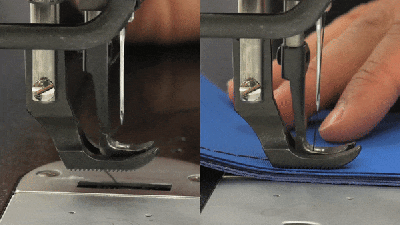
This is a compound walking foot machine. Let’s break that down. ‘Walking foot’ means that that the foot — the many-varied and interchangeable part that holds the fabric down to the bed — has a set of feed dogs that help push the fabric along the from top side at the same time that the regular feed dogs feed the fabric from underneath. The ‘compound’ part refers to the little middle bit, which moves up and down at the same time as the needle and also walks the fabric along.
Here’s a great visual explanation of the differences between drop-feed, walking foot, and compound walking foot machines. Compound walking foot machines are great for my needs in that they give an even stitch through multiple thick layers of fabric, which is what I need to sew vinyl, canvas, and leather. Like I said in the first post, industrial machines are purpose-built. This one is for heavy duty use, and it spent many years doing upholstery work. It even made a motorcycle seat!
That Motor Though
The motor in a standard sewing machine for home use is pretty small — about the size of a fist. Even the motor in my “heavy duty” Singer 4452, which is supposed to have 50% more power than a regular domestic’s motor, is pretty darn small compared to Connie Consew’s motor. This is a 1/2 horsepower clutch motor. The operating instructions I have are for a 206RB-4, and I’m really not sure what the differences are between the 206RB-3 and the -4, though I suspect they are slight. According to the manual, it will do 3300 stitches per minute! Look how fast it goes:
Because it’s a clutch motor, it runs continuously when powered, even when not sewing. It’s rather loud, too, although not as loud as I was expecting. Still, I will have fun replacing it with a servo motor that be much quieter and easier to dial in the speed. Gonna miss those cool controller buttons, though. Maybe I can re-use the motor for something else, like a go-kart. Just need an inverter.
For A Few Dollars More
Even though I really like this machine as-is, there are a few upgrades I’d like to do. Many of them are along the lines of what [Eric Strebel] did to his industrial Pfaff — move the pedal more toward the right, swap out the clutch motor for a servo motor, and augment the built-in light with something containing many small LEDs.
I’m going to try to replace the pad on the knee lifter, which lifts the presser foot from its normally-down position. While there’s nothing wrong with it, the outside is all crackled and flaky. I’ve already looked into it, and it seems that I’ll have to buy the entire knee lifter assembly. Maybe I’ll just make a little shower cap-style slipcover for it instead. I also think I’d like to get a link belt because they’re cool looking, though that might not be a good idea. I’ll have to check with my local sewing machine shop and see what they think.
Sew What?
Now that I have this baby, I can make better bags and backpacks with less hassle and at higher speeds. I could even start making stuff out of leather. I plan to start my sewing adventure with Connie Consew by working on a half-finished bag made from upholstery fabric that the Singer 4452 couldn’t handle. But first, I’m going to go through and give her a tune-up, making sure she’s got plenty of oil.


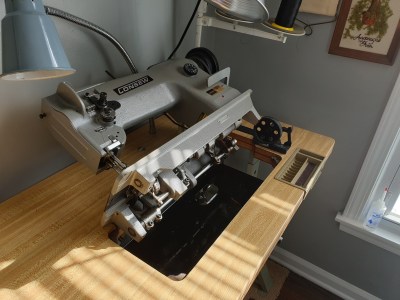
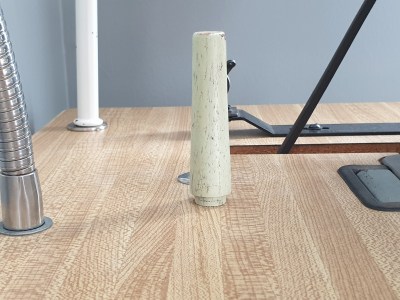
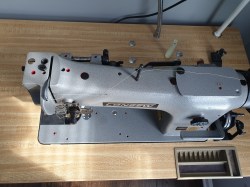
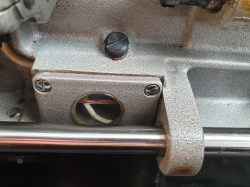
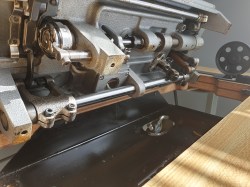
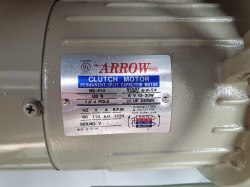
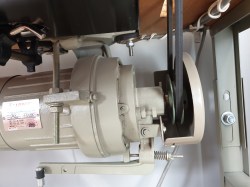
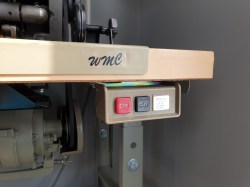














Best thing you can do is to upgrade to the servo motor as soon as you can. Those clutches are hell.
Pretty dubious thing if you ask me, considered servo motor is the same thing as “clutch motor” aka induction motor(in this case synchronous – e.i. with permanent magnet) but wired differently and required pretty complicated IC’s just adding another point of failure and less efficient.
But you can do:
1) Switch to 3-phase
2) add proper VFD
3) add proper Regenerative braking(some VFD already have it builtin)
3) YD autoswitch for lowering switch-on surge (and again some VFD already have it builtin )
4) replace friction coupling by EM/EPM coupling
5) one or two shaft encoder HS or optical(depend on required resolution and VFD some came with retrofitting kits)
6) add Biological sensor so your machine stop sewing your or some else wet biological things(still rare but some VFD may came with it builtin otherwise just few ESP for failover or and similar board will help )
7) Modified rotor into PMSRM (since COTS replacement for rotor practically not exist, it will required a lot of heave machinery, magnet and other metal sawing and in some case you need complete rewinding with thinner litz wires and new VFD, so this step can be safely skipped if you not ready for mouths of fun machining and rewiring with not warranted result)
I don’t know why you consider a servo motor to necessarily not have all the first three things you listed. Are you assuming a servo brushed motor?
The rest would be nice to have but are pretty far outside the scope and budget of a standard motor replacement. Especially getting a PMSRM, this is a sewing machine, not a Tesla.
I think when the author says servomotor, they mean a BLDC with a VFD. I see no reason to have an encoder of any kind. BEMF control would be more than enough to give the control desired for a sewing machine.
Well… like I said PMSRM largely unnecessary unless you can DIY from exiting rotor for cheap (x10 speed won’t hurt for large project or small businesses).
seem I need add TL;DR:
Cheap VFD for SM 400W for single or 3-phase around 10-$15.
I doubt you can beat it price with new motor.
It’s a sewing machine, not a race car! Down boy.
Servo motor is going to eliminate the friction clutch and give better low speed performance (torque and control).
That’s the truth. Servo motor is the way to go.
Absolutely true.. my JUKI DDL8700 has a 110v Servo motor and I love it’s performane.
That would be overkill for a sewing machine, an electric scooter BLDC motor would be a cheap way to do it.
I upgraded my 206R with a Consew “servo” motor and it was the best thing I ever did. It was not expensive. It’s variable speed DC. Then I sold the whole deal :-(
A industrial sewing machine is a wonderful machine. Loved mine which was as old Phaff . Just straight stitch but took me a bit of time to understand timing.
I agree
Disagree. Servo motors are cheaply built and will be in the landfill for years before a “clutch motor” shows the first sign of wear. Learn how to use the clutch. Problem solved. (There’s no such thing as a “clutch motor.” They’re just large, heavy duty electric motors connected to the drive pulley by a clutch. Just like a car engine with a manual transmission is connected to, and disconnected from, the rest of the drive train by a clutch.) An old US made industrial motor blows away a cheap Chinese servo motor with unreliable IC cards any day.
I’ve owned a 206 RB for 49 years. The motor runs very smoothly and quietly. If your motor is noisy just buy another. Servos are expensive, overrated and overpriced. All 4 of my machines run from those motors and I’ve never had to replace one. From covering entire buildings with vinyl and fabric, hemming billboards to fabricating ballistic wear for the US Secret Service, I have sewn tens of thousands of items on my 206 and just last Tuesday found out it’s value is more than 5 times what I paid for it but priceless to me.
It’s a workout to run one for extended periods of time that is for sure. It doesn’t matter where your pedal is you will adapt to it and it will feel perfect for you. Running a 206 requires a period of acclimation and soon you will love yours as I do mine. Just get on it and use it Remember that someone else put miles on it before you and it served them well.
The Consew 206 RB is a lifer. Once you grow to know it you will love it. My advice is the same for any machine…… that machine is YOUR machine, don’t loan it or let other people use it. They are delicately engineered mechanical devices and once you run the machine for a while you will see that letting someone else just get on it and sew is the express route to the repair shop.
Good luck to you on your purchase. Treat your 206 well and it will last your lifetime. You can’t say that about the current computer driven machines.
Sew on and on!
Very nice! You’ll want to turn the handwheel by hand once in a while to make sure it’s not getting stiff again. The fact that it was stuck at first may be simply an initial lack of lubrication, OTOH it may have been lubricant that turned to varnish with age. I’ve unseized – and then done it again – a number of domestic machines, and the principles are the same. If it happens again, you can use some 99% isopropanol to help dissolve the varnish. Chase that with some WD-40, then with whatever oil is recommended for that beast. Run it for a bit without sewing, let it drain, empty the oil pan, then oil it again
If you care about accurate colour rendition of what you’re sewing – some domestic sewers do – then pay attention to the colour temperature of the LED’s you use for the lighting upgrade. Some domestic machines incorporate red LED’s with variable brightness to allow tweaking of colour rendering. And of course you’ll want the lights dimmable – you may find that you sometimes need extra brightness that’s helpful in the short term but too bright for a long sewing session.
Stock up on needles – you’ll want to change them fairly frequently. A dull needle is more likely to break; depending on how fast you’re sewing and how heavy the material is, a needle break could scar the throat plate and possibly cause other damage, such as changing the needlebar height or throwing the timing off.
Have fun with your new machine!
Be careful with alcohol around vintage machines.
Many of the old black machines shellac protecting the black japanning.
If you use alcohol on those old machines, you risk ruining the finish.
You can put fresh shellac on them to fix things if you accidentally get alcohol on the shellac – but no everybody has shellac handy.
Industrial machines never have a Japaned finish. It would be totally impractical. Almost always have a hammered (industrial) finish.
The watts will give you horsepower. https://www.wolframalpha.com/input?i=400+watt+to+hp
Having worked as a Furrier for a number of years – our finisher’s machine – (making the lining for the coat – usually Silk) had an ACIENT singer – with a 1/4 horse motor – watching an accomplished seamstress using that machine was a joy – that seam up the side of the lining was done at max speed – nary a missed stich or crooked seam – I found how strong the machine really was when I was reupholstering some cushions – the bead cord had a leather wrapper – and two layers of upholstery on either side – zip, zip, zip like it was sewing paper. Just as a test one day we sewed three leather belts together. You had to respect that kind of power – if you got careless – you could very well wind up sewing two fingers together…
I did eight layers of denim the other day, and Connie just yawned as she zipped through them.
Wholly cow 8 layers of denim. I mean, of course, right? But I would have never even imagined someone needing to do so, let alone an industrial machine being ‘unbothered’ by it.
I was going to offer to straight up ‘Bedazzle’ your entire workspace with COB LEDs in exchange for the old motor (provided you are in the bay area…) but the above comment was spot on. I’m surrounded by LEDs… constantly wiring up new novel uses for them…and yet, I very much dislike the lighting characteristics of LEDs in general but most ESPECIALLY the color. Honestly if it mattered to me and I was in your shoes I would literally have like 6 of those folding true color sewing lights. The old ones. The new ones are LEDs I think!
High-CRI white LEDs and white LEDs in various color temperatures are available.
Some people even (try to) make high-CRI arrays out of low-CRI white LEDs with different color temperatures, or even color LEDs of different colors (not just red + green + blue), to fill in the spectrum, but going to such lengths isn’t often necessary.
This is all good, but do you have any of them RGB lights and infinity mirror table for this machine?
My mom has an old treadle machine that we have literally sewn through layers of old fashioned thick inner tube material with. Some of these machines are total beasts!
The machine I am talking about was a conversion from a treadle machine -they just bolted on the motor and clutch to the belt – the treadle modified to operate the clutch…
I worked in orthotics and they had similar machines–could sew a stack of 7 layers of steer hide together. There were stories about (infrequent) accidents that would chill your blood. I’ve used table saws without guards that were less scary than the 2 Hp sewing machines.
I have operated several industry sewing machines. I love them all. I’ve worked in the garment industry all my life.
I also own four, 1single needle and 3 overlooks. If you never used industrial sewing machines…you don’t know what you are missing. They can have needle guards attached in front of the needle so if your finger gets to close, it will hit the guard first.
Not all have them but you could buy one. They are small of course they fit in front oof the needle. Like a little cage. They cannot obstruct the view of the needle and where you are sewing.
Connie, your article was great! Thanks.
Hmm, that little cage sounds interesting. Both times I’ve put a machine needle through my finger, it was with that darn zipper foot. Most any other foot, it’s pretty hard to get that close. I will still be super duper careful, though!
Thank you!
If all you need is the knee lifter pad, save $50 and buy one for a different machine & redrill the clamp if necessary. I see (all out of stock, though) several other replacement kits with fewer parts for around $20 each. Maybe Ebay?
If you feel really adventurous, take a stab at just replacing the pad on yours. Maybe a thick piece of neoprene rubber sheet, cut to size and glued on?
When I operated sewing machines in garment manfacturing, if the rubber on the knee lift was worn,
Or maybe just didn’t feel like it ” fit” to our knee comfortably….we would just warp a soft fabric around it until we liked the ‘feel’ of it against our knee. Worked great! And yes, you can order just the rubber
Pad, you do not have to order the whole contraption.
Your console looks like it is great shape. You should see the machines in the factories, some are old and look terrible, they are worn and there is a fabric strip wrapped around the center section with about 40 straight pins stuck in it, which is very handy by the way, and they might have tape stuck to them here and there, usually helps to mark your seam allowance.
I have Brother single needle and I love it.
AND if anyone is interested I have a very nice Brother industrial overlock that I have decided to
sell. It has a clutch motor. Which I am used to. I’ve always used one.
I just sold my Juki industrial overlock. I’m down sizing, and yes they are very heavy and you need he
Let moving them. I’m thinking about putting it on eBay. If you know anyone that could be interested I won’t list it on eBay. I’m not certain how anyone contacts another person through this site, but if interested let me know. I live in North Central PA. I really don’t want to ship it anywhere.
By the way, I am a professional pattern maker, retired. I worked at WOOLRICH, INC.
Sadly they went out of business here. A company in Italy bought it. I saw 2 floors of production sewers loose they jobs. Very sad. WOOLRICH at one time had a whole floor of different overlocks bumper to bumper , they offered their employees a chance to buy one before they sent them out. I asked the sewing machine mechanic to pick what he knew was a good machine. He did, and I bought it.
If anyone is interested figure out how we can connect, because I don’t know…sorry.
Debbie Emig
I’ve got a “Connie”, too! My day job is leather /vinyl upholstery, and this machine is absolutely the KING of walking foot machines! I also have a fiber /textile design biz, and have another at my studio at home; this one is new and has a servo. At work, it’s a clutch… And it’s noisy! My tip for you: look for presser feet. My all time fave foot is actually a 1/4″ double-welt foot. It serves me in four different ways: double welt cord-making, obviously, single welt cord-making, 1/4″ topstitch foot, and the width of the foot is easy to follow for a nice scant-half-inch seam allowance. A zipper foot is always handy, too. 😊
Julie knows her stuff. 1/4″ welting foot is ideal for 90% of your work and is much better than the stock one you have now. I ran a shop with several industrial machines and the RB-5 version of your Consew was my favorite. It had the larger bobbin which we needed for sewing truck tonneau covers. Your best lubricant is plain ole mineral oil they sell at Walgreens for constipation. It’s clear, doesn’t yellow, and cheap. Take Julie’s advice and hunt down a welting foot and don’t be afraid to shape it with a grinder either. Have fun.
Why replace the knee lifter? You can buy the pad at wawak for $10
Oh yeah? Thanks for the tip!
Yes you can, and Central Penn Sewing Machine Co., Inc.
They have everything! Parts for all kind of industrial machines.
They are online, you can call them as well and they will also help you.
You can buy a pad at wawak for $6.
Thanks for the tip! It was even cheaper than that! :)
The critical miss for my wife is the lack of a zig-zag stitch.
You can buy industrial sewing machines that do zig zag. But that’s all they do,
I must say I’m just a liiiitle bit jealous. But what to do, I have no space at home 😢
The table is only 4′ by 20″! See how nicely it fits in a corner?
That is funny, I just got rid of my Pfaff industrial machine. I put a servo on it because it’s pretty necessary unless you are very skilled with the clutch motor. It was just to heavy and not portable. I find that I prefer to take my machine to the job and industrial isn’t the solution. I thought about a bench top industrial but ended up with a janome hd300p. It’s less powerful but still powerful enough and portable
Try a Sailrite. They are portable and a walking foot.
Sailrite is legendary amongst the cross-section of ppl in the know/ppl who need HD but portable. They even have 12v models.
You can buy just the rubber part of the knee pad rather than the whole assembly. I also had a cloth cover sewn for the knee pad with elastic around the perimeter. It looked like a larger version of a cloth jam jar cover.
I have one of these, I just found the operator manual in an old box (so thankful for that). Mine came out of the Penaljo Shoe Company where my uncle worked. I haven’t had a chance to sew anything yet but I have loads of vintage leather to make some really cool things. I’m so happy I found your article!
Just purchased a new titan 750BL, the machine body looks exactly the same. Love how it works so effortlessly making fur mitts and hats.
I needed this because although I have several machines, I want one also.. My parents were tailors and I grew up with a power machine in the house. I did learn to sew on it, but I never learned how to do the maintenance. My Dad kept it oiled and after he passed, my mother took it to a local guy who took care of it for her. But alas, that machine technician was forced into retirement due to impending dementia. So I gave her one of my Singer machines which she used until she passed on. Now years later I wished that I had at least kept that power machine table which was tossed when family cleaned out the house.
I have one sewing machine and I have made quilts and other clothing for my family and would not buy any other machine they are work horses and not plastic I have mine now for 50 yrs and I love ❤this machine
I’m a skilled craftsman, though not much of a sewer, and this article came up at random on my Google page. Despite not being part of your “target” audience, I found the article written with such clarity, I had no trouble (at all!) following and becoming absorbed into the world of industrial sewing machines. I now find myself intent on dreaming up a project (tent?, laundry hamper?, tool bag?) that could justify my buying one. Your subtle use of humor was also appreciated. Most DIY articles are either too stuffy and dry, or they mistake cloying “cuteness” for wit (example: puns like “sew easy”, or “… left me in stitches!” Ugh…). Anyway, nicely written! I’m going to figure out how to subscribe to Hack-A-Day on the strength of your article. Thx!
These ppl are not corny housewife “bloggers” “publishing” nonsense via WordPress about subjects they saw on Pinterest and have no experience in – to get you to buy some BS that comes with a kickback from Beff Jezos…
These ppl r SRS BZNZ
How sad is it that not-bs is *startling* to see nowadays
I have this same machine and have no clue what to do with it.
I never heard what that machine sold for . I bought a domestic machine but l was really needing industrial. Maybe you might want to make a trade for domestic and cash , for your industrial.
Hi there! Have a brand new Consew that I will sell for a good price. It’s an incredible machine but prefer the Sailrite at the moment for my needs
What are you asking for it
What model is your consew what would you consider a reasonable price? How do we get it to Harrisburg Pennsylvania? 7175031307
eBay has tons of industrial machines, new and used and many different brands.
You can search there and get an idea what they sell for.
If I made videos, would you watch them?
I would
I have an industrial Pfaff I use. I love it. Always comes in handy. I once made a jeep top using a 5 gallon bucket in strips for the lip on windshield and sides. Sewed right through the plastic.
would love to see a video sewing thru plastic bucket
That table! So jealous.
I truly enjoyed reading your article which seemed to have just popped up on Google on my phone . Having owned an industrial machine decades ago, loved it, but I felt like I was waking up my entire neighborhood whenever I sewed, not to mention my family. If I had all this information back then, I would probably still have it . I have portable machines that do the job, but it does take longer. So, I may need to look into industrial machines! 😊
I want the same sewing machine any ideas where I can look for one? Please I need to know. I am an Uhpolster and I don’t have a machine. I need to practice what I learned before I forget it. So if y’all guys have any information as to where I can find one! or where to look? It would be great and so helpful of you guys. “ I Thank you in advance. “
I have one left from my mom. Where do you live? I live in Jacksonville Florida.
I have one for sake. What state are you in?
I have been searching all over for one. I live in Michigan and In need if an I ndustrial machine badly
I live in Sun City Az
I have a Thompson machine, mini walking foot. Model PW-201
Try ebay
I love this sewing machine!
I bought my 206 RB Singer in 1982 brand new in 1982. I still use it today. I use it for upholstery in planes, trucks, and automobiles. And lots of other stuff too. Enjoy! Great selection.
This is an awsome add on. I have the commercial serger and hemmer. Theres no better way to go then these dinausaurs. 3thumbs up
I’ve sewn on many industrial machines working in garment manufacturing, as I mentioned in an earlier reply. I started sewing production when I was 18. There are so many brands and different types. You can find new and used industrials online. Of course start with Google. You will end up going down the rabbit hole finding more and more sites having to do with industrial machines. Ebay has them all the time. I’ve seen them on Craig’s list as well. When I sewed production…of course you usually do the same operation. You sew the same part over and over all day. You get paid piece work. The harder that particular sewing part is the more you will get paid for one piece. The parts come come in bundles from the cutting room. Maybe a dozen per bundle or 50 per bundle. I at one time sewed for Glamorise, Foundations. They manufactured many different styles of bras. I sewed shell lace edging onto the straps of some of the styles. The lace was about 1/4″ wide and came in fairly large rolls which where attached to my machine, and there was a special attachment in front of my machine where the lace went through so it was guided directly under my needle. As I sewed the lace would continually unroll. I sewed up one curved side to the top which was very narrow, about 1/2″ wide. I needed to learn how to go around that top narrow section across the top and down the other side which was a different curve to the end. Then do it again on the next piece. On this operation there was a steep learning curve. A lot of it is hand eye coordination. I thought I’m going to have to stop and pivot at two 45° angles and still make money. Most operations a sewer can sew the piece and never stop until the end. It took me awhile but I learned to pivot the strap under the needle on both angles without stopping! It wasn’t long before I would not even have to stop the machine and do a dozen straps straight on. As I was sewing one holding it with my right hand , I then would pick up another strap and have it ready to insert in the folder as I ended the strap in front of it, that probably took 6 months to accomplish. The only thing that stopped me from going faster was the machine! And you know how fast those machines are! Once in awhile I’d run off the edge of the strap and then stopped, ripped out some stitches, pull the lace and the strap back where I ran off and petal to the metal…right back into the rhythm. If you sew a small mistake in a bundle of a dozen or more, believe me, you will get it back to correct once it went to the quality girls! Ha! That was in the 70’s, before most of the garment manufacturing went off shore to be made cheaper, There were about 10 different types of garment manufacturing in my area…rural area. To sew the garments. They are still here but all the seamstresses are not. They are warehouses that store their garments AFTER they are sent back from China or Mexico or Honduras or India….. I saw hundreds and hundreds of mostly women lose their jobs. The only thing they knew how to do. I learned to create and sew my own clothes at a very young age, my mother taught me. She also worked in garment factories all her life. She learned how to sew when she was young. She could make anything. From wedding gowns to upholstery. She was amazing. I went back to college to study Fashion Design and of course if you can sew and read patterns that’s half the battle. Some students never used a sewing machine let alone read a pattern. But the one thing you have is 6 hour long classes in pattern drafting. I loved the pattern making. More than the designing, but they go hand in hand. If you can draft a pattern from only a picture it is a great accomplishment. I took to patterns like a duck to water. I excelled at drafting them. Back then I did them on the table. I came home got a position with a huge knitwear factory. Talk about trial by fire. But I learned how to make patterns for knits and how to sew knits plus all the different sewing machines needed to create the clothes. 2 needle cover, 3 needle cover, mock safety stitch and on. Several years. Then they downsized. Well the sewers all lost their jobs. That company was private label for catalogs. Lands End, Eddie Bower, Izod, Macy’s, Victoria Secret was our largest account. Sportswear. They don’t do much sportswear anymore. It seems to be all under garments. I did all patterns on the table for years. Then came Gerber and Lectra. Garment pattern drafting software. CAD. I last worked for WOOLRICH as patternmaker, grader. That was private label as well, but we only made WOOLRICH patterns. There I learned how to pattern parkas that could have 50 pattern pieces. And they had to fit, or if they found their way to the cutting room for production and one piece was off, you were in big trouble. That never really happened, at least not to me. I developed many outerwear garments while there. Straight from a huge knitwear manufacturer to wovens. I forgot to mention I learned Gerber CAD there and drafted patterns on the computer. And it wasn’t AUTO CAD. I wrote all of this for the benefit of home sewers or just anyone interested. If it is too long I understand if you don’t want to include it in your replies. Thank you.
I really liked the story of your sewing career. Very interesting. Thank you
Hello Debra
Do you still do piece work ?
I’m a start up and need help.
Thank you. Mary Turner
I am sorry Mary…I just saw your note. I am retired but if you may still have questions, I may be able to help.
Love your story! I fell into sewing leather at 15 when home economics class only had an industrial machine left as the girls grabbed the light machines to work on. I had been sewing with my mom, grandma and aunt since I was 5 by then. Now, I do custom leather work. By referral only
I have a industrial sewing machine like posted with the exception that it’s a singer and I’m trying to sell it so if anyone is interested give me a shout for more details…757-636-5631
You will love the 206, I’m a professional upholsterer and my 206 is the workhorse of the shop. If you practice a bit and get used to the clutch motor, there’s really no need to go to servo, I actually tried 2 different ones, and went back to the clutch motor ( though needle positioning on the fancier servo was kind of nice , when the encoder was not messing up). Actually, once your experienced, you can sew a single stitch, or as fast or slow as you want with the clutch. Up to you.
Likewise the light, I just screw a 60w equivalent led bulb in the existing fixture, seems perfect.
Oil it everytime before using. You will probably want to pick up some additional presser feet, at least one beading or welt foot, and a right and left hand zipper foot make nice Addison’s, and can be had cheap on eBay.
Now that I’ve made a bag or two with it, I am more comfortable than I though I’d be with the clutch motor. It is so, so loud, though, so I’ll probably still replace it with a servo motor.
I want a. Sewing machine like this. How much they cost?
I’ve been seeing used ones on craigslist for about $400 and up.
Hey i have industrial sewing machine. I got it on a trade. I live in ohio, i have $500 in it.
I have a 1926 singer upholstery machine very similar to the one above
That I’m interested in selling
It was used to make leather belts hats and upholstery for cars
it still works great
I’m in Arizona
My 1 st 3 rd 5 th job was sewing. 7 the 9 and 10 as well. But I wanted to let you know hobby lobby lets you use (on phone) coupon 40% off any regular priced item, I get the most beautiful leather hides, suede, smaller pieces as well. All are reg priced not higher than ??? Maybe $12.00 or so. I like to get the larger ones to make all kinds of things. Bags, belts, custom many fun things. Also I have even used my industrial to see a dryer belt, a motor car belt of some kind for a friend (it got him to the auto parts store. And my vacuum belt. I am so fortunate to own many machines even a huskavarna. I know they are chainsaw people too. Anyways. Happy sewing.
Hobby Lobby got rid of the 40% coupon altogether! I have a small bag of leather scraps that I’ve had around forever, so I’m excited to try those out before I go buying any leather. How awesome that you sewed all those belts!
For buying leather, I often go to The Salvation Army store & buy leather coats. I recently purchased a 339-3 direct from Consew, it’s a double needle & I love it! I have an older version of the same at work. I am a flag seamstress in upstate NY. I’ ve modified some attachments from Amazon to work with my machine & was able to bue bobbins there as well.
Oh, that’s a great idea about the coats! What all did you do to modify the attachments?
Hidehouse.com. great resource, Springfield leather is another.
Leather is like fabric. With its grain being that of how long is the hide. You won’t have stretch laying with the grain. A cow, will get rounder! So laying your pattern in different direction is where stretch will come in. I’ve been sewing leather 50 years. I love it because it bends! The smell and texture. You will get the hang of your foot control. Starting the needle by turning the wheel seems to allow better foot control.
I bought a CONSEW last year. Mine is portable I have it on a heavy duty table. I wanted an industrial machine so bad. Well let me tell you I found it not as easy to use as your plug and sew machines. This post is what I needed because I wasn’t sure about how often you oiled an industrial machine. Hit right on the money. I have a learning curve but will continue to work with it. Self taught upholsterer here and needed a workhorse. So glad I found this post!!!! Will continue to watch for more updates.
I have a similar machine without the walking foot..and dang it just blows through things so fast I can’t use it. I’m in need of needles and lots of oil (it’s the suction kind), and eventually a new motor for slower speed/more control. I know it will see leather, just haven’t done it yet. Any ideas on where to get needles and which oil to use?
https://www.thethreadexchange.com/ for needles (and or any commercial supply like South Star)
and I use mineral oil, the same stuff you get at the drug store for constipation (or Johnson’s Baby Oil if you can stand the scent). South Star sells it by the gallon but shipping might kill ya. They also sell motors!
Good luck and have fun!
Well that was fast! My real issue is I have no idea which needles to order. I took the machine as payment for a project, and the former owner has left the state. Ideas?
Consews have been around for a long time and people who deal in commercial/industrial sewing machines are quite used to recommending things like needles and thread sizes for them. The folks at South Star (it’s actually Southstar – https://southstarsupply.com/ ) are experienced experts and they’re pretty friendly too. And there are other industrial sewing supply companies out there. It’s been over 20 years since I’ve even thought about that era of my life that their names escape me, but they’re out there. https://www.goldstartool.com/ is another one we used to use.
Generally a 135×17. Schmetz. Wawak sewing source is a great supplier of most all you need.
135×17
Central Penn Sewing Machine Co., Inc.
In Bloomsburg, Pa.
Hey Moose …I have 2 old Singer Spartan 192k machines. One was my mother’s and what I learned on and the other I bought on ebay for parts but ended up using it instead. Can I also use mineral oil?? Mom always used 3 in 1 oil or sewing machine oil. Thanx
You sure can. I recommend it universally for any sewing machine. Mineral oil is colorless and odorless and is just a more pure form of petroleum with no unnecessary additives so it doesn’t build up, dry out, and get gummy. The added benefit is that it’s also cheap and available at any drugstore.
For a quick, if not permanent, but inexpensive fix for the speed, you can downsize the wheel on the motor to reduce the rpms. Ebay for needles in 10-packs or higher. I like schmetz. Oil comes in quarts, half gallons and gallons. Gold star tool has it, as well as 100 packs of needles in varying sizes.
How much does a machine like that cost i own a consew and have decided on selling it . perfect condition
Should be about 800
Depends entirely on where the machine is located. Shipping is unrealistic so the global market thing is pretty much out the window. Where I live, a working Consew 206RB goes for maybe $500. I pick up slightly lighter duty industrial machines, like a Singer 241-12, for under $100 regularly, with table, motor, and drawers full of feet and needles.
On your bobbin you may have a tension disc. Slightly arched which will go in the bobbin holder, so the bobbin doesn’t “travel” in its case. Looks just like my last Consew! I have Artisan now. Not to hard to throw your self outta timing .
Today, I switched out the original clutch motor for a Workhorse Servo motor on mine. So much more control and very quiet.